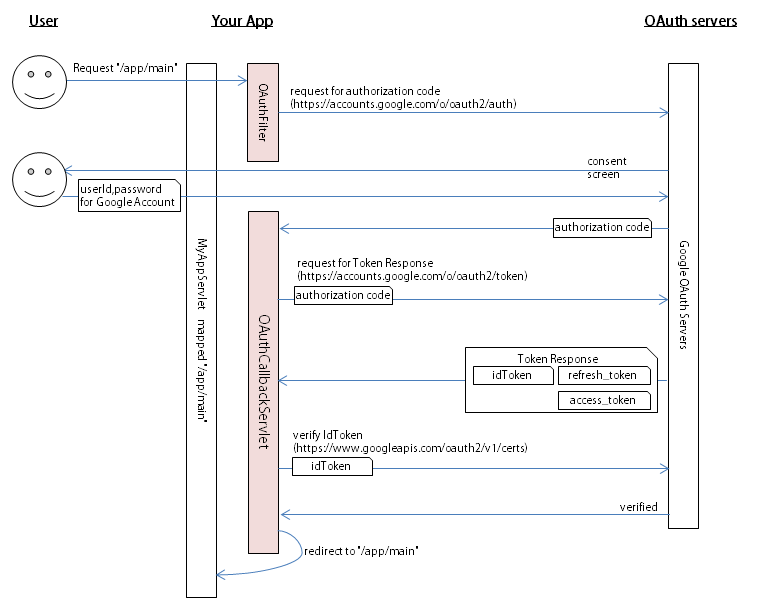Overview
google-oauth2-client-servlet is a library for OAuth2/OpenId connect.
You can easily develop your servlet-based webapp using google OAuth2/OpenId connect.
It is licensed under MIT.
Quick start
This example code can retrieve a user's Google userInfo after OAuth2-flow.
implement Servlet which can login with Google.
Implement the OAuth 2 / OpenId connect process simply by inheriting OAuthCallbackServlet and OAuthFilter and returning simple settings like this.
You can clone/download this example from here.
https://github.com/riversun/google-login-servlet-example-simple.git
(1/4)implement callback servlet which extends OAuthCallbackServlet
- should override getAuthRedirectUrl() returns OAuthCallbackServlet's URL
- override saveRefreshTokenFor()/loadRefreshTokenFor() to persist refresh_token if you want.
@SuppressWarnings("serial")
public class MyOAuthCallbackServlet extends OAuthCallbackServlet {
static final String OAUTH2_CALLBACK_URL = "http://localhost:8080/callback";
@Override
protected String getAuthRedirectUrl() {
// Should return url of callback servlet(this servlet)
return OAUTH2_CALLBACK_URL;
}
}
(2/4)implement servlet filter which extends OAuthFilter.
- should override getAuthRedirectUrl() returns URL of MyOAuthCallbackServlet
- should override getScopes() returns OAuth2 SCOPE
public class MyOAuthFilter extends OAuthFilter {
@Override
protected String getAuthRedirectUrl() {
return MyOAuthCallbackServlet.OAUTH2_CALLBACK_URL;
}
@Override
protected boolean isAuthenticateEverytime() {
// If true, execute OAuth2-flow every time<br>
return true;
}
// Return OAuth2 scope you want to be granted to by users
@Override
protected List<String> getScopes() {
final String OAUTH2_SCOPE_MAIL = "email";
final String OAUTH2_SCOPE_USERINFO_PROFILE = "https://www.googleapis.com/auth/userinfo.profile";
return Arrays.asList(OAUTH2_SCOPE_MAIL, OAUTH2_SCOPE_USERINFO_PROFILE);
}
}
(3/4)implement Main servlet which can access Google Services with OAuth2
-
credential which contains access_token and refresh_token will be stored in the HTTPSession.You can obtain via wrapper class.
OAuthSession.getInstance().createCredential(req) -
unique userId can be obtained via wrapper class.
OAuthSession.getInstance().getUserId(req);
public class MyAppServlet extends HttpServlet {
@Override
protected void doGet(HttpServletRequest req, HttpServletResponse resp) throws ServletException, IOException {
resp.setContentType("text/html; charset=UTF-8");
// Get credential including access_token
GoogleCredential credential = OAuthSession.getInstance().createCredential(req);
// Get unique userId
String userId = OAuthSession.getInstance().getUserId(req);
Oauth2 oauth2 = new Oauth2.Builder(
new com.google.api.client.http.javanet.NetHttpTransport(),
new com.google.api.client.json.jackson2.JacksonFactory(),
credential).build();
// Get userInfo using credential
Userinfoplus userInfo = oauth2.userinfo().get().execute();
final PrintWriter out = resp.getWriter();
// Show result
out.println("<html><body>You are already logged in to Google.");
out.println("<br>");
out.println("<b>OAuth2/OpenId connect result</b><br>");
out.println("userId=" + userId);
out.println("userInfo=" + userInfo);
out.close();
}
}
(4/4)Run on local jetty
- Add OAuth2callback servlet for "/callback"
- Add OAuthFilter for "/app/*"
- Add MainServlet for "/app/main"
- The main servlet is called after passing the OAuthFilter
public class MyAppMain {
public static void main(String[] args) throws IOException {
startServer();
}
public static void startServer() {
Server jettyServer = new Server(8080);
ServletContextHandler ctx = new ServletContextHandler(ServletContextHandler.SESSIONS);
ctx.addServlet(new ServletHolder(new MyOAuthCallbackServlet()), "/callback");
ctx.addFilter(MyOAuthFilter.class, "/app/*",
EnumSet.of(DispatcherType.INCLUDE, DispatcherType.REQUEST));
ctx.addServlet(new ServletHolder(new MyAppServlet()), "/app/main");
jettyServer.setHandler(ctx);
try {
jettyServer.start();
jettyServer.join();
} catch (Exception e) {
e.printStackTrace();
}
}
}
Add Maven dependency
<dependency>
<groupId>org.eclipse.jetty</groupId>
<artifactId>jetty-server</artifactId>
<version>9.4.4.v20170414</version>
</dependency>
<dependency>
<groupId>org.eclipse.jetty</groupId>
<artifactId>jetty-webapp</artifactId>
<version>9.4.4.v20170414</version>
</dependency>
<dependency>
<groupId>org.riversun</groupId>
<artifactId>google-oauth2-client-servlet</artifactId>
<version>0.8.2</version>
</dependency>
Create client_secret.json and put it in the top of src folder
Create credential if you have not created it.
-
open https://console.cloud.google.com/
- select API & services
- Credentials
- Create credentials
- OAuth Client Id
- Web application
- Add authorized redirect url to http://localhost:8080 (for testing)
- click Save
-
download client_secret.json from https://console.cloud.google.com/apis/credentials
- Rename downloaded file to client_secret.json and save it on the top of the src folder.
Run
run MyAppMain.java
OAuth2 flow and how this library works
More practical examples
In the above example you know authentication/authorization and application login are inseparable.
To create a practical web application,
It is necessary to separate application level login and OAuth2-flow.
And it is necessary to design separately the part of authentication "who are you?"
and the part of authorization to grant permission (to the API).
download / clone
I would like to introduce an example of separating app login and OAuth.You can clone and easy to run it.
https://github.com/riversun/google-login-servlet-example-on-jetty.git
run
run com.example.MyAppMain
Example app flow
- Click Login with Google
- authentication (with id/password for Google Account)
- authorization (with Google's consent screen/permission check)
- login to app with uniqueId provided by Google
- Get userInfo from Google with access_token(refresh_token)
- Click Log out to forget OAuth2 state and set app state "logout"





